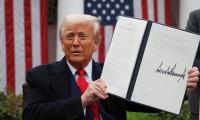As Pakistan prepares to enhance its climate commitments in the form of NDCs 3.0 under the Paris Agreement’s Article 4, it is crucial to draw lessons from international best practices to ensure a robust and effective Nationally Determined Contribution (NDC).
Brazil and the United Arab Emirates (UAE) experiences provide insightful models for shaping Pakistan’s NDCs 3.0, particularly in integrating climate action with sustainable economic development, ensuring resilience, and fostering cross-sectoral coordination.
Pakistan’s 2021 NDCs, while ambitious in their intent, faced several deficiencies that need to be addressed in NDCs 3.0. One of the critical shortcomings was the heavy reliance on very ambitious conditional targets, with 35 per cent of the committed 50 per cent emission reduction contingent upon international financial assistance. This approach limited the country's ability to achieve tangible climate action without external support. Moving forward, Pakistan must focus on designing more realistic and domestically driven mitigation and adaptation measures, ensuring that a greater portion of its climate action is implemented through national resources without undermining the socioeconomic development and remaining on the second stage of the environmental Kuznets Curve.
Another major gap was the lack of a clear and enforceable implementation roadmap. The 2021 NDC outlined broad targets but failed to provide sector-specific pathways, institutional accountability, and measurable progress indicators. To overcome this, Pakistan’s NDCs 3.0 should introduce a detailed sectoral breakdown, enhanced transparency measures, and a strengthened Monitoring, Reporting, and Verification (MRV) framework. The UAE’s MRV system provides a strong model for integrating data transparency and accountability.
Pakistan’s 2021 NDC also did not fully integrate emerging climate finance instruments such as carbon markets under Article 6 of the Paris Agreement and green bonds. Brazil and the UAE have leveraged these mechanisms effectively to finance their decarbonisation strategies. Pakistan should institutionalise a domestic carbon trading market, explore green financing options, and align its fiscal policies with sustainable development goals to ensure long-term financial sustainability for climate action. Pakistan can also look at Brazil’s approach to leveraging international funding for reforestation and carbon sequestration projects as a model.
Brazil’s NDC outlines a vision for 2035 that integrates ecological transformation with economic growth, leveraging science, indigenous knowledge, and policy coherence. Pakistan must adopt a similar long-term approach, linking its climate goals with its economic development objectives. The government should institutionalise a ‘National Climate Resilience Pact’ akin to Brazil’s ‘Pact for Ecological Transformation’, ensuring a whole-of-government and whole-of-society approach to combating climate change. Furthermore, Brazil's focus on expanding conservation areas and restoring degraded ecosystems should serve as a model for Pakistan's afforestation and reforestation efforts.
Pakistan should also implement a multi-decade investment strategy similar to Brazil’s Amazon protection policies, which have integrated financial incentives for landowners to maintain forests. Given Pakistan’s vulnerability to land degradation, climate-smart land-use policies should be incorporated into the long-term NDC framework.
The UAE’s third NDC includes an ambitious commitment to a 47 per cent reduction in emissions by 2035, compared to a 2019 baseline. Pakistan should establish clear, economy-wide emission reduction targets, moving beyond sector-specific goals to a holistic decarbonisation strategy. Given the country’s reliance on fossil fuels, a realistic transition plan must be developed to phase out high-emission activities while ensuring economic stability and energy security.
The UAE’s Green Growth Strategy and its integration of clean energy into industrial and urban sectors provide a framework that Pakistan can adapt. By setting milestones for renewable energy integration in power generation, transportation, and manufacturing, Pakistan can ensure a more structured and achievable emissions reduction pathway.
Brazil’s commitment to a just energy transition highlights the importance of decarbonising its energy matrix while promoting economic instruments for sustainable development. Similarly, the UAE has invested in renewables and carbon capture technologies to align with its Net Zero 2050 strategy.
Pakistan must accelerate investments in renewable energy, particularly in solar, wind, and mini/micro hydropower, ensuring that the transition does not disproportionately impact vulnerable communities dependent on traditional energy sectors. However, to achieve this a detailed decarbonisation plan of the power sector is required; for example, the utility of Just Energy Transition Partnerships (JETPs) is still not being considered in Pakistan.
Both Brazil and the UAE emphasise robust climate governance frameworks. Brazil’s ‘Commitment to Climate Federalism’ fosters coordination across federal, state, and municipal governments, ensuring integrated climate action. The UAE’s National Council on Climate Action aligns federal and emirate-level policies. Pakistan should institutionalise inter-ministerial coordination mechanisms to ensure policy coherence across climate, energy, agriculture, and industrial sectors.
Operationalisation and revamping of the ‘National Climate Change Authority’ to the ‘National Climate Policy and Implementation Authority’ modelled on the UAE’s cross-sectoral council can help streamline efforts while incorporating Brazil’s multi-stakeholder engagement strategies to ensure climate policies align with economic and social development objectives.
Brazil and the UAE are leveraging carbon markets as a key tool for achieving their NDCs 3.0, integrating emissions trading mechanisms to attract green investments and incentivise low-carbon transitions. Brazil has established a legal framework for carbon markets through its National Decarbonisation Plan, which includes sectoral emissions caps, tradable carbon credits, and offsets from forestry conservation projects.
One of Brazil’s most significant carbon finance strategies is the expansion of REDD+ (Reducing Emissions from Deforestation and Forest Degradation) programs, allowing companies and international partners to purchase forest-based carbon credits. The country is also integrating its domestic carbon market with international emissions trading schemes, creating opportunities for Brazilian industries to earn revenue while reducing emissions. By implementing transparent Monitoring, Reporting, and Verification (MRV) mechanisms, Brazil ensures that carbon credits are credible, making its carbon market an attractive avenue for climate finance.
Similarly, the UAE has developed a comprehensive approach to carbon markets by combining domestic emissions trading with global partnerships. The UAE’s ALTERRA climate finance initiative, valued at $30 billion, plays a central role in funding carbon market activities, and supporting emissions reductions through investment in renewable energy, industrial decarbonisation and energy efficiency projects.
The UAE is emerging as a regional carbon trading hub by collaborating with platforms like Singapore’s Climate Impact X and launching voluntary carbon markets to support corporate sustainability. It has also integrated carbon capture and storage (CCS) in its oil and gas sector, enabling carbon credit generation as part of transition strategies. Similarly, Brazil and the UAE are leveraging market-driven approaches to fund their NDCs 3.0, balancing emissions reduction with economic growth.
Pakistan must operationalise its domestic carbon market and mobilise international climate finance through its National Climate Finance Strategy and Dashboard, ensuring transparency in mitigation and adaptation projects. Public-private-people partnerships should scale up green investments. Pakistan can also explore Brazil’s forest-based carbon offset projects and the UAE’s sovereign green bonds to attract global investors.
Given its vulnerability to climate disasters, Pakistan should integrate climate adaptation into national planning, focusing on water security, urban resilience, and climate-smart agriculture. Brazil’s agroforestry initiatives and the UAE’s climate-resilient urban planning offer valuable models. Establishing a National Adaptation Fund, similar to the UAE’s, would help finance long-term resilience projects.
Pakistan should enhance public engagement in NDC formulation through consultations with civil society, academia, businesses, and indigenous communities. Digital platforms can facilitate crowdsourcing ideas and tracking progress. The Ministry of Climate Change’s research arm, GCISC, is working to integrate NDCs 3.0 across sectors.
Pakistan must also strengthen its Monitoring, Reporting, and Verification (MRV) systems, aligning with the Paris Agreement’s Enhanced Transparency Framework. A ‘Pakistan Climate Data Portal’ akin to Brazil’s DataClima+ can enhance transparency, while the UAE’s real-time emissions monitoring offers a model for industrial oversight.
By learning from Brazil and the UAE, Pakistan can develop robust NDCs, institutionalise climate governance, and ensure inclusive participation to meet its climate commitments.
Twitter/X: @Khalidwaleed_
Email: khalidwaleed@sdpi.org
The writer has a doctorate in energy economics and servesas a research fellow in the Sustainable DevelopmentPolicy Institute (SDPI).
Invention of Bakelite by Belgian chemist Leo Baekeland in 1907 marked beginning of large-scale plastic production
It was found that at least 60% of answers given by AI were inaccurate or blatantly incorrect
Apple and other manufacturing giants face skyrocketing costs as their China-based supply chains get taxed into oblivion
Pakistani mills buy American cotton, turn it into products, and sell those goods back to American consumers
Senior Pakistani delegation is scheduled to visit Washington for trade and tariff negotiations
Sialkot’s products meet stringent international quality standards, ensuring reliability and safety in medical...







